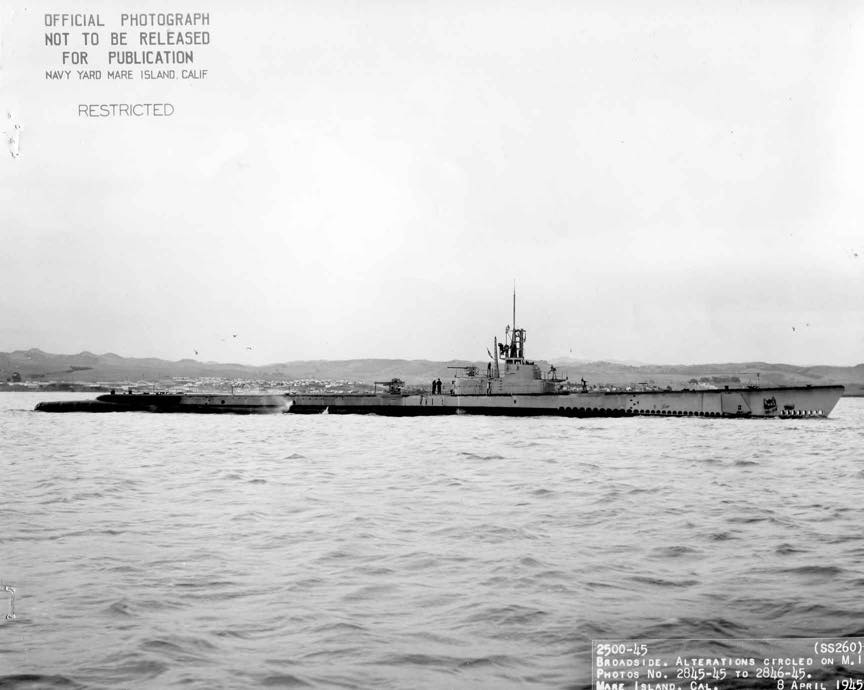Lapon SS260

Lapon I
(SS-260: dp. 1,526 (surt.), 2,424 (subm.); 1. 311'9"; b. 27'3"; s. 20 k. (surf.), 8.7 k. (subm.); cpl. 60; a. 1 5", 10 21 tt.; cl. Gato)
The keel of Lapon (SS-280) was laid 21 February 1942 by Electric Boat Co, Groton, Conn., Iaunched 27 October 1942; sponsored by Mrs. J. B. Oldendorf, wife of Rear Admiral Oldendorf; and commissioned 23 January 1943
Comdr. O. G. Rirk in command.
Completing trials and training in Long Island Sound, Lapon departed New London for the Pacific 4 May 1943, arriving at Pearl Harbor 1 June. She departed 24 June for her first war patrol which was spent in the Sea of Okhotsk. Sea of Japan. and off the east coast of Hokkaido and Honshu. Lapon was the first U.S. submarine to slip through a mined strait into the Sea of Japan, the enemy's own backyard, on 3 July.
The submarine, Comdr. L. T. Stone in command, departed 26 September for a close inshore patrol off the south coast of Honshu. After sinking cargo ship Taichi/ Maru 18 October, Lapon returned to Pearl Harbor 4 November 1943 and departed for the west coast 7 November for an overhaul at Mare Island Navy Yard.
Refitted with four new engines, the submarine departed for the South China Sea via Pearl Harbor 22 January 1944. Lapon relentlessly sought out torpedo targets and inflicted heavy damage on the enemy. In well-planned and skillfully executed attacks, she sank cargo ships Toyokuni Maru 8 March, Nichirei Maru 9 March, and Hokuroku Maru 18 March; and inflicted heavy damage to several small craft. Lapon departed for Fremantle, Australia, arriving 1 April 1944.
Departing 25 April, Lapon arrived in the South China Sea and on 23 May detected and tracked a convoy. During the early hours of 24 May, the submarine sank cargo ships Wales Maru, and Bizen Maru. Lapon cleared the area at sank speed chased by an escort and returned to Fremantle 6 June for refit.
Underway for the eastern part of the South China Sea 29 June, Lapon spotted a cruiser and destroyer, the latter escaping at high speed. Four days later she sent cargo ship Kyodo Maru No. 36 to the bottom. In the early evening of 31 July 1944, a convoy was sighted in Palawan Passage. Hungry for the kill, Lapon closed in on a night submerged radar attack and sent tanker Tinshin Maru to Davy Jones's Locker and damaged two other vessels. Lapon headed for Australia and moored at Fremantle 10 August.
Lapon sailed for the South China Sea on 4 September Lt. Comdr. D. G. Baer in command. She rendezvoused with submarines Flasher and Bonefish and became a member of a dangerous wolfpack. Early in the morning of 21 September, the submarine contacted an enemy hospital ship and allowed the ship to pass unharmed. That afternoon Lapon spotted smoke on rounding Palauic point and commenced closing. As she neared attack position U.S. carrier based planes attacked this convoy, inflicting heavy damage on the enemy. Lapon attacked remnants of the convoy 22 September and sank the cargo ship Shun Yuan. The next day Fla~her and Lapon made a coordinated attack on several ships, Lapon sinking the tanker Hokki Maru. Patrolling off the coast of Luzon 10 October 1944, Lapon intercepted a Manila-bound convoy and sank the cargo ship Ejiri Maru. Assigned lifeguard duty, the submarine was on station during the air attacks preliminary to the invasion of the Philippines; and 21 October departed for Australia, arriving at Fremantle 31 October.
Lapon left port for her seventh patrol 23 November and took position on a scouting line to prevent enemy reinforcements from reaching Mindoro and Leyte. Aircraft contacts were many and ship contacts few. Lapon was the last submarine to prowl Lingayen Gulf! before the invasion, and was ordered out of the area at high speed the day of the first landings. She headed for Pearl Harbor arriving 21 January 1945. Departing for the west coast i days later Lapon moored at Mare Island Navy Yard 31 January.
Bound on her last patrol, Lapon arrived at Pearl Harbor 22 April, stayed there for a month then headed for Guam arriving 5 June. Next day she sailed on a special mission ot lifeguarding for a British carrier strike force and for B-24 and B-29 bombers striking the Japanese homeland. Returning to Guam 20 June, she headed for Saipan 4 days later to join submarines for a picket boat sweep ahead of Admiral Halsey's forces which were to attack Tokyo area targets. Upon completion of sweeps, Lapon went on lifeguard duty off Tori Shima until 7 July when she steamed for Midway, briefly stopping at Saipan for temporary repairs, mooring 23 July at the mid-Pacific island. The day she was to sail for another war patrol, hostilities ended. She departed for the Atlantic coast 26 August and arrived at New Orleans, La., 20 September 1945. She remained there until she departed 24 October for the Texas coast arriving Galveston 25 October. Two days later she berthed at Houston. Lapon got underway for Staten Island, X.Y. 30 October, arriving 4 November. She remained at New York until 8 January 1946, when she sailed for New London, arriving the same day. Lapon was placed out of commission in reserve 25 July 1946.
Recommissioned at Portsmouth, N.H., 13 April 1957, Lapon remained in the Portsmouth vicinity until 10 August, when she was decommissioned and struck from the Navy list. On 8 August 1957 she was transferred to Greece under the Military Assistance Program and serves the Greek Navy as Poseidon (S 78).
Lapon was awarded the Navy Unit Citation for her brilliantly successful third, fourth, fifth, and sixth patrols and received four battle stars for World War II service.
